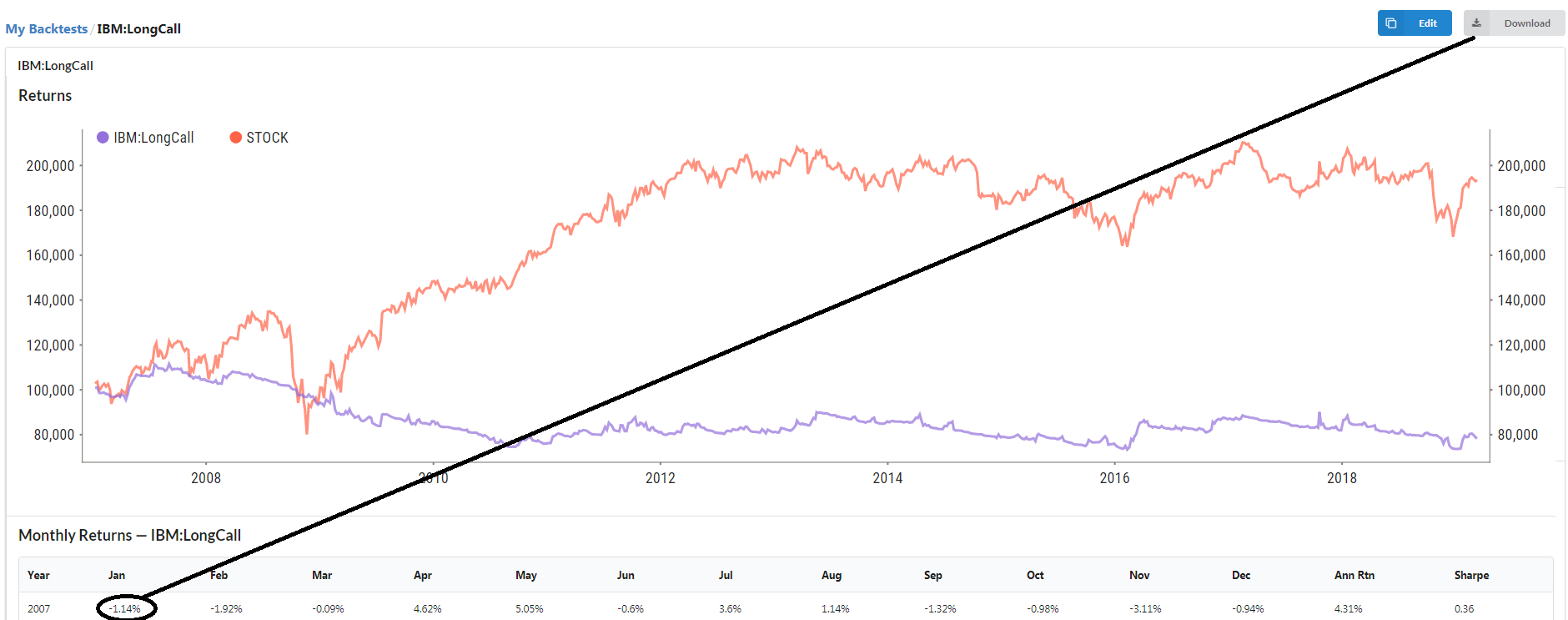Backtesting
Tuesday, March 12th 2019
How To Calculate Backtest Returns
Try this simple example to understand how to calculate daily, monthly, yearly and annualized returns for any options strategy.
Summary
This article explains how to calculate daily, monthly, yearly, and annualized returns for any options strategy using a simple example of a backtest for a long IBM call. The article shows how to calculate the monthly return by starting with daily returns and summing them up. The annual return is calculated by adding up the monthly returns, and the overall annualized return is obtained by multiplying the average monthly return by 12. The article provides a link to further documentation for more information.
I have a confession to make: I am a recovering CPA. Please don't tell anyone.
But you don't have to be a CPA to figure out how we calculate our daily, monthly, yearly and annualized returns in our backtester.
Let's take a simple example, a backtest for a long IBM call, the default backtest in Wheel. Run the backtest without changing any default parameters, click on the backtest name to see the report, and hit the Download button in the top right hand corner.

You will get a zip file in your Downloads folder and you want to open the zip and click on the folder called 'Strategy Outputs'. In that folder will be OptionReturns.csv, OptionStats.csv and OptionTrades.csv.
Let's start with the OptionTrades.csv. Clicking on column S will sum the individual trade profits to $2541.80. That should match the OptionStats.csv

TotStratP&L$ of ($2,541.80) which it does. Let's turn our attention to Jan 2007 return of -1.14%. How is that calculated?

To calculate monthly return, start with daily returns. Looking at the first trade, on 1/4/2007 we bought the Feb 100 calls for $1.875. The trading rule is to travel 75% of the bid ask spread to trade. In this case, the market was $1.80 x $1.90. the formula for buying is the bid + .75(ask-bid) or $1.80 + .75($1.90-$1.80)=$1.875. The daily return will be the market to market of that option the next day minus the purchase price minus commission of .01 divided by the stock price at the opening of the trade. The bid-ask for Feb 100 calls 1.50 x 1.60 or a mid-price of $1.55.
The daily return for 1/5/2007 was -0.36% =~($1.55-$1.875-$0.01)/$98.31. As in the following pic, in cell B3 the 1/5/2007 daily return from the file OptionReturns.csv matches. Do this for each day in January and sum the daily returns and you get -1.14%, matching the Jan '07 returns in the OptionStats.csv above.

The annual return for 2007 is just adding up the months starting with -1.14% for January and ending with -0.94% for December and getting 4.31%.
To get the overall annualized return for the strategy of -1.46%, get an average of all the monthly returns, here -.12% and multiply that average monthly return by 12 to annualize and get -1.46% matching the OptionStats number.
And that is how it is done. Please see the documentation for more information.
Disclaimer:
The opinions and ideas presented herein are for informational and educational purposes only and should not be construed to represent trading or investment advice tailored to your investment objectives. You should not rely solely on any content herein and we strongly encourage you to discuss any trades or investments with your broker or investment adviser, prior to execution. None of the information contained herein constitutes a recommendation that any particular security, portfolio, transaction, or investment strategy is suitable for any specific person. Option trading and investing involves risk and is not suitable for all investors.
All opinions are based upon information and systems considered reliable, but we do not warrant the completeness or accuracy, and such information should not be relied upon as such. We are under no obligation to update or correct any information herein. All statements and opinions are subject to change without notice.
Past performance is not indicative of future results. We do not, will not and cannot guarantee any specific outcome or profit. All traders and investors must be aware of the real risk of loss in following any strategy or investment discussed herein.
Owners, employees, directors, shareholders, officers, agents or representatives of ORATS may have interests or positions in securities of any company profiled herein. Specifically, such individuals or entities may buy or sell positions, and may or may not follow the information provided herein. Some or all of the positions may have been acquired prior to the publication of such information, and such positions may increase or decrease at any time. Any opinions expressed and/or information are statements of judgment as of the date of publication only.
Day trading, short term trading, options trading, and futures trading are extremely risky undertakings. They generally are not appropriate for someone with limited capital, little or no trading experience, and/ or a low tolerance for risk. Never execute a trade unless you can afford to and are prepared to lose your entire investment. In addition, certain trades may result in a loss greater than your entire investment. Always perform your own due diligence and, as appropriate, make informed decisions with the help of a licensed financial professional.
Commissions, fees and other costs associated with investing or trading may vary from broker to broker. All investors and traders are advised to speak with their stock broker or investment adviser about these costs. Be aware that certain trades that may be profitable for some may not be profitable for others, after taking into account these costs. In certain markets, investors and traders may not always be able to buy or sell a position at the price discussed, and consequently not be able to take advantage of certain trades discussed herein.
Be sure to read the OCCs Characteristics and Risks of Standardized Options to learn more about options trading.
Related Posts



